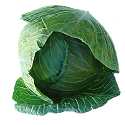|
Brassica oleracea (Cabbage, Brussels Sprouts, Broccoli, Kohlrabi,
Cauliflower, Kale) [= Brassica cretica, Brassica
insularis, Brassica rupestris]
Life
> eukaryotes >
Archaeoplastida >
Chloroplastida
>
Charophyta > Streptophytina > Plantae (land plants)
> Tracheophyta (vascular plants) > Euphyllophyta > Lignophyta (woody plants)
> Spermatophyta (seed plants) > Angiospermae (flowering
plants) > Eudicotyledons > Core Eudicots > Rosids >
Eurosid II > Order: Brassicales > Family: Brassicaceae > Genus:
Brassica
Originates from the Atlantic seaboard of Europe and the
Mediterranean. It has been used as a vegetable for more than 2500 years and
through selective breeding for particular characteristics of the plant,
six main vegetables have been produced from this one species.
Wild Brassica oleracea is native to the
Atlantic seaboard of Europe (e.g. coastlines of Britain and the Bay of Biscay)
and the Mediterranean basin. Six main vegetables have been derived from this
wild stock through selection of favourable cultivars by people:
|
Vegetable |
Derived through selection for: |
|
|
Kale |
loose, uncompact leaves (most closely resembles the wild
plant). |
|
|
Cabbage
|
enlarged terminal buds. |
 |
|
Brussels sprouts |
numerous lateral buds. |
|
|
Kohlrabi |
enlarged stems. |
|
|
Cauliflower |
more extensive flowering structures. The whiteness is
caused by the outer leaves blocking sunlight and preventing the formation of
chlorophyl. |
|
|
Broccoli |
enlarged stems and flowering structures. |
|
It is thought that one of the reasons it has been possible
for people to produce so many vegetables from this one species is because it is
geographically diverse so that there is a great genetic diversity from which one
can draw favourable attributes through selective breeding.
Use of Brassica oleracea can be traced back to
Greek and Roman times, at least 2500 years ago. The Greeks were using non-heading Kale-like varieties.
The Romans in addition were using a loose-headed cabbage as well as a possible
precursor to broccoli. However, it is only from about 1600 onwards that the main
varieties (except Brussels Sprouts) are clearly referred to in writings.
Brussels Sprouts only started being eaten by the English in the 19th century
although its origins go back earlier in continental Europe. Modern day cultivars
of Brassica oleracea have been produced that are more pest resistant and which have solid heads that
can withstand mechanical harvesting, shipment and storage.
The various forms of Brassica oleracea are mainly
cooked or used in salad. Pickled cabbage, known usually as sauerkraut, is a way
of cooking cabbage that was introduced to Europe by the Tartars. The
pickling process does not destroy the Vitamin C and pickled cabbage was used by
the Dutch and British colonists as a defense against scurvy and was also
important to the health of Europeans living through long winters.
Captain Cook kept his crews healthy on pickled cabbage.
Brassicas contain substances called goitrins which can interfere with the body’s
uptake of iodine and encourage goiter (enlargement of the thyroid) but this is
only a problem in people who have a persistent iodine deficiency.
References
-
Sauer, J.D. 1993. Historical geography of
crop plants - a select roster. CRC Press, Boca Raton, Florida.
Text by Hamish Robertson
|
